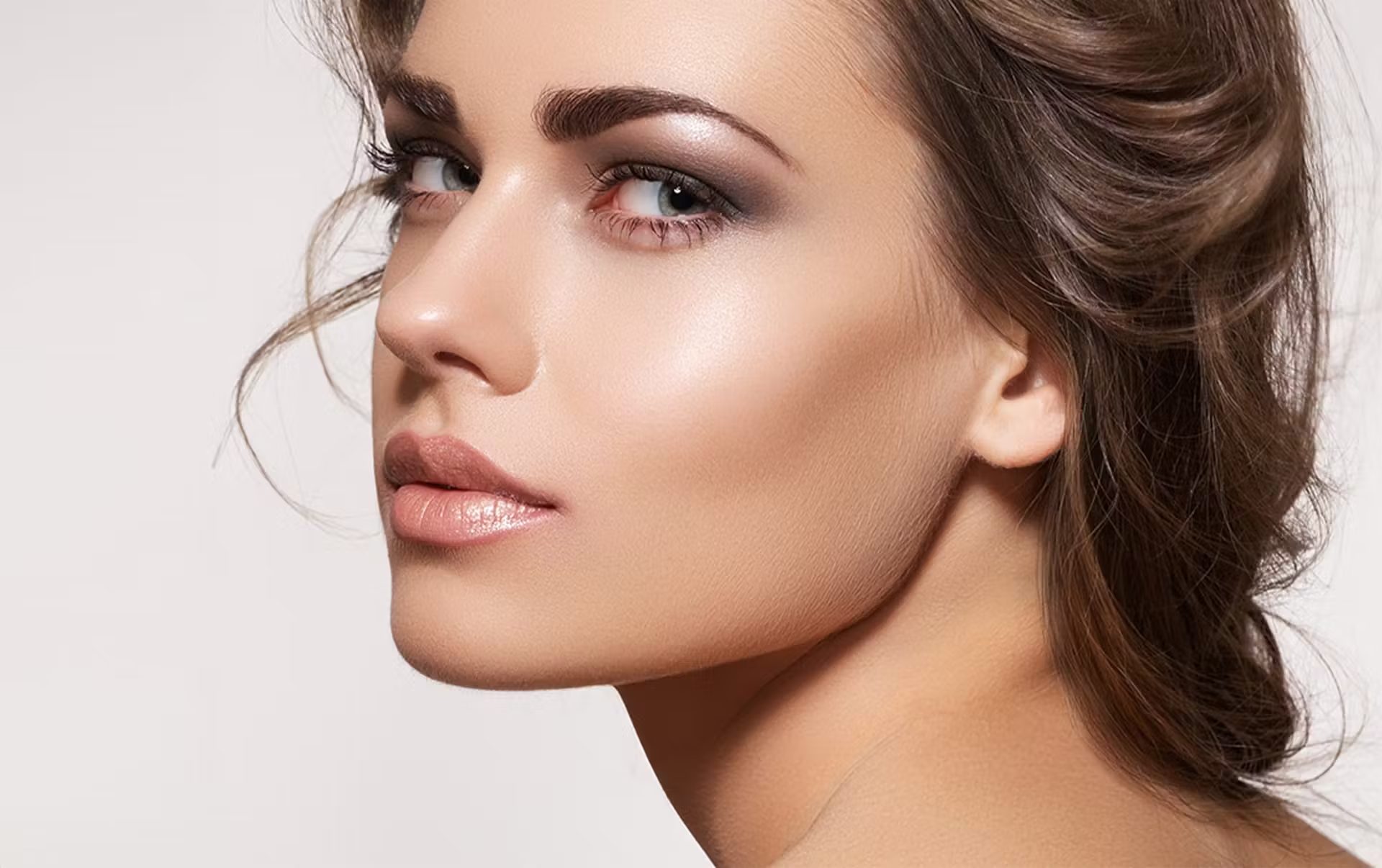surgical rhinoplasty has long been considered the gold standard in this regard; however, dermal fillers serve as a less invasive and really customizable alternative for those interested in precision and non-permanent corrections. This review discusses the mechanism, indications, clinical considerations of nasal dermal fillers, and their effectiveness in asymmetry correction evidence-based.
What Are Dermal Fillers?
Dermal fillers are injectable gel-like substances developed to restore lost volume, highlight facial contours, and improve aesthetic imperfections. The two most commonly used fillers in the indication of nose reshaping are hyaluronic acid and calcium hydroxylapatite.
1. Hyaluronic Acid Fillers
Hyaluronic acid fillers, such as Juvederm Voluma, Restylane Lyft, and Belotero Balance, are leading products in the market for various reasons, which include versatility, biocompatibility, and reversibility.
-
Mechanism of Action: The HA binds water molecules, which means it increases the area in volume and elasticity. In cases of nasal asymmetry, 1-2 mL of HA filler is thus strategically injected into deficient areas of the nose to bring about a smoothened, well-balanced appearance.
-
Clinical Evidence: A study conducted and published in Aesthetic Plastic Surgery in the year 2022 documented 93% success in the correction of mild to moderate nasal asymmetry with HA fillers.
2. Calcium Hydroxylapatite Fillers
CaHA fillers, like Radiesse, are more viscous and longer-lasting. Administered less in the nose, they become ideal for structural corrections that call for high viscosity.
-
Longevity: The effects of CaHA fillers will last for as long as 18 months, while HA-based fillers last for up to 9–12 months.
-
Limitations: Because of their non-reversible nature, these materials are not advised for first-time nasal corrections or slight adjustment of the nose.
Market Insights
The global dermal filler market is estimated at USD 5.4 billion in 2023, with demand constantly on the rise for non-surgical rhinoplasty, which comprises about 17% of all filler procedures.
How Do They Work?
Dermal fillers correct the asymmetry of the nose by bringing volume back to those areas which are lesser or unbalanced. This is achieved by injecting into appropriate places using a fine-gauge cannula or needle, depending on area and effect required.
1. Mechanism in Nose Correction
-
Balancing Proportions: Fillers smoothen depressions, enhance the nasal bridge, or fill gaps arising from injury or congenital reasons. For example, a dorsal hump may be “erased” visually by injecting filler above and below the bump to create a straight profile.
-
Precision Techniques: The practitioners will more often than not use a method called linear threading or a bolus technique to achieve this precise depth placement of the filler. Advanced imaging tools such as 3D facial scanners are now integrated into the delivery in order to ensure even distribution of the product.
2. Volume and Placement
-
Volume Requirements: Most nasal corrections require between 0.5 mL to 1.5 mL of filler. In the case of slight asymmetries, 0.5 mL of product may be used, while in cases requiring more profound changes, up to 2 mL of product may be used.
-
Layering Approach: Many practitioners will opt for a layering approach whereby they inject small quantities at a time, building up rather than risking overcorrection or vascular compromise.
3. Duration of Results
Its longevity is determined by the material used in filling and by the metabolic factors. Generally, HA fillers take 9-12 months while CaHA fillers may provide structural integrity for as long as 12-18 months. It is short-lived in high-mobility areas such as the nasal tip.
Advantages of Nose Fillers
1. Non-Surgical Nature
Compared to rhinoplasty, this requires no incisions or general anesthesia, hence it is an attractive option for patients with time constraints or surgical phobia.
-
Downtime: Recovery is limited, and for most patients it does not take more than 24–48 hours before they return to their routine work. In one comparative study among the filler patients compared to rhinoplasty, 95% less post-procedure downtime was reported.
-
Cost-Effective: The average price for a nonsurgical nose correction is from $500 to $2,500, while surgical rhinoplasty costs between $8,000–$12,000.
2. Adjustable Results
Another advantage of HA fillers is that they are easily dissolved with hyaluronidase, should the patient be dissatisfied. Clinical data indicates complications requiring reversal occur in less than 2% of cases when performed by certified injectors.
3. Immediate Results
Unlike surgical treatments that take weeks for the swelling to go down and the results to be noticeable, fillers show their result within one hour of the treatment session. In fact, as early as one hour post-treatment, 87% of patients demonstrated significant improvement in nasal symmetry.
Fixing Nose Asymmetry
1. Common Causes of Asymmetry
Asymmetry of the nose could be because of congenital issues, trauma, or after having previous surgeries. The common issues include:
-
Deviated Nasal Bridges: These are commonly corrected by injecting fillers into one side to align the profile.
-
Sunken Areas: Sunken areas can be treated with up to 0.5–1 mL of HA filler for flattening.
-
Crooked Nose Tips: The border of the crooked tip is reshaped with small-volume, placed injections around the columella or alar base.
2. Clinical Outcomes
A 2021 study of 150 patients suffering from post-trauma nasal asymmetry showed that 88% achieved optimal correction with HA fillers after an average of 1.3 sessions.
Genetic asymmetries patients reported a 92% satisfaction rate after a single treatment session.
3. Long-Term Considerations
Although temporary, fillers provide symmetry maintained by repeated treatments every 12–18 months. Patients suffering from constant asymmetry because of septal deviation may use fillers in combination with other minimally invasive interventions, like injections of botulinum toxin, for better results.
Safety and Risks
1. Common Side Effects
Other common side effects include swelling, erythema, and bruising, which will resolve in 3-7 days. These occur in approximately 20% of patients but do not impact the eventual outcome.
2. Serious Complications
-
Vascular Occlusion: Complication arising in 0.05% of procedures due to a situation where fillers inadvertently block the blood vessels. This risk is considerably reduced when a cannula with a blunt tip is used.
-
Blindness: The rarest, occurring once in every 100,000 procedures, hence usually related to an inappropriate technique.
-
Prevention: Qualified professionals do not inject in the dangerous zones, and it could be because the ultrasound guidance can outline structures such as the supratrochlear artery.
3. Patient Safety
In the recent analysis, 85% of the complications happened in non-medical environments; hence it is of great importance to seek the services from licensed professionals.
How Long They Last
1. Longevity by Material
-
HA Fillers: 9–12 months, if used in low mobility areas, for example, in the nose.
-
CaHA Fillers: They last for 12–18 months but are less forgiving in case minor adjustments have to be made.
2. Maintenance Treatments
Most patients return for touch-ups in 9–12 months to maintain symmetry.
There have been studies showing that repeated treatments over a period of three years lead to cumulative improvements, allowing the reduction in the required volume of fillers by up to 30%.
3. Factors Affecting Longevity
-
Metabolism: The faster one’s metabolism, the faster fillers break down; this is especially true in people below 30 years.
-
Lifestyle: UV exposure and smoking hasten the degradation of fillers.
Choosing the Right Expert
1. Certification and Training
Practitioners should be board-certified in dermatology or plastic surgery. In a 2023 survey, patients treated by certified specialists showed 98% satisfaction compared with 72% for non-specialists.
Specialized clinics, like ELE GLOBAL, are exclusively engaged in the practice of injecting dermal fillers with the help of novel techniques and quality products.
2. Reputation and Reviews
Online reviews from actual patients are a necessity. This is evident from the fact that 74% of patients choose their practitioner based on online reviews.
ELE GLOBAL boasts an excellent reputation, as well, as a provider of premium aesthetic solutions, which again points toward using trusted products to achieve optimal results.
3. Consultation Process
Pre-procedure consultations should involve 3D imaging, detailed facial assessments, and a review of patient goals. Record patients that go through appropriate consultations are said to increase their likelihood of achieving desirable results by 42%





